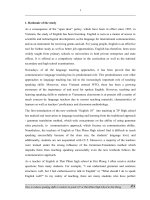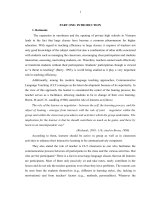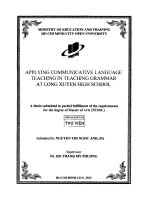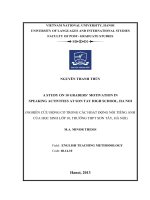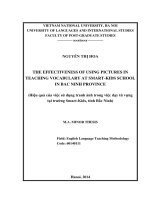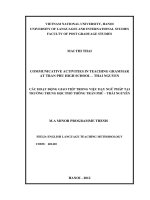Teachers'''' attitution towards using checking techniques in teaching vocabulary at Bacninh specialized High School Bacninh province
Bạn đang xem bản rút gọn của tài liệu. Xem và tải ngay bản đầy đủ của tài liệu tại đây (489.06 KB, 14 trang )
VIETNAM NATIONAL UNIVERSITY
UNIVERSITY OF LANGUAGES AND INTERNATIONAL STUDIES
FACULTY OF POST-GRADUATE STUDIES
----------
NGÔ THUỲ DUNG
TEACHERS’ ATTITUDES TOWARDS USING
CHECKING TECHNIQUES IN TEACHING VOCABULARY
AT BAC NINH SPECIALIZED HIGH SCHOOL
BAC NINH PROVINCE
(Quan điểm của giáo viên đối với việc sử dụng các thủ thuật kiểm tra
trong việc dạy từ vựng tại trường THPT Chuyên Bắc Ninh,
tỉnh Bắc Ninh)
MINOR PROGRAMME THESIS
Field:
ENGLISH TEACHING METHODOLOGY
Code:
60 14 10
Supervisor: KHOA ANH VIỆT, M.A
Ha Noi, 2011
VIETNAM NATIONAL UNIVERSITY
UNIVERSITY OF LANGUAGES AND INTERNATIONAL STUDIES
FACULTY OF POST-GRADUATE STUDIES
----------
NGÔ THUỲ DUNG
TEACHERS’ ATTITUDES TOWARDS USING
CHECKING TECHNIQUES IN Teaching VOCABULARY
AT BAC NINH SPECIALIZED HIGH SCHOOL
BAC NINH PROVINCE
(Quan điểm của giáo viên đối với việc sử dụng các thủ thuật kiểm tra
trong việc dạy từ vựng tại trường THPT Chuyên Bắc Ninh,
tỉnh Bắc Ninh)
MINOR PROGRAMME THESIS
Field: ENGLISH TEACHING METHODOLOGY
Code: 60 14 10
Ha Noi, 2011
v
TABLE OF CONTENT
Declaration ………………………………………………………………………...
i
Acknowledgements ………………………………………………………………..
ii
Abstract ……………………………………………………………………………
iii
Table of contents …………………………………………………………………..
v
Abbreviation ………………………………………………………………………
viii
List of tables and figure …………………………………………………………..
ix
PART A: INTRODUCTION ……………………………………………………..
1
1. Rationale …………………………………………………………………………
1
2. Purpose the study ………………………………………………………………..
2
3. Scope of the study ……………………………………………………………….
2
4. Methodology …………………………………………………………………….
3
5. Organization ……………………………………………………………………..
3
PART B: DEVELOPMENT ……………………………………………………..
4
CHAPTER 1: THEORETICAL BACKGROUND ……………………………..
4
1.1. Vocabulary …………………………………………………………………….
4
1.1.1. Definition of Vocabulary ……………………………………………...
4
1.1.2. Classification of Vocabulary …………………………………………..
5
1.1.3. Principles of Vocabulary teaching …………………………………….
7
1.1.3.1. Purposes for teaching vocabulary..............................................
7
vi
1.1.3.2. What to teach? ………………………………………………..
8
1.1.3.2.1. Form ………………………………………………….
8
1.1.3.2.2. Grammar ……………………………………………..
8
1.1.3.2.2. Collocation …………………………………………...
9
1.1.3.2.3. Meaning ………………………………………………
9
1.1.3.2.4. Usage …………………………………………………
10
1.1.4. Techniques of Vocabulary teaching currently used …………………...
12
1.1.4.1. Techniques in presenting vocabulary ........................................
12
1.1.4.2. Techniques in practicing vocabulary ........................................
13
1.1.4.3. Techniques in consolidating and revising vocabulary ..............
14
1.1.5. Strategies to teach vocabulary ………………………………………..
15
1.1.5.1. Presenting new vocabulary …………………………………..
15
1.1.5.2. Practicing words …………………………………....................
16
1.1.5.3. Revising words ………………………………………………
17
1.1.6. Memory and storage system ………………………………………….
18
1.2. Attitudes ……………………………………………………………………….
20
1.2.1. Definition of attitudes …………………………………………………
20
1.2.2. The role of attitudes in language teaching …………………………….
20
1.3. Related studies …………………………………………………………………
21
1.4. Summary ……………………………………………………………………….
22
CHAPTER 2: RESEARCH METHODOLOGY ………………………………..
23
vii
2.1. Context of the study ……………………………………………………………
23
2.2. Research questions …………………………………………………………….
24
2.3. Participants …………………………………………………………………….
25
2.4. Data collection instruments ……………………………………………………
26
CHAPTER 3: DATA ANALYSIS, DISCUSSION OF MAJOR FINDINGS
AND RECOMMENDATIONS …………………………………
27
3.1. Data analysis and discussion of major findings ……………………………….
27
3.2. Recommendations ……………………………………………………………..
39
3.3. Summary ……………………………………………………………………….
45
PART C: CONCLUSION ………………………………………………………...
46
1. Conclusion and Implications …………………………………………………….
46
2. Limitations and suggestions for further studies ………………………………….
47
REFERENCES ……………………………………………………………………
48
APPENDIX …………………………………………………………………
50
1
1. Rationale
In Vietnam, since the 1990s, teaching and learning English has become a topical issue
appealing for concerns of both practitioners and researchers. It is common knowledge that
learning a foreign language mainly involves learning the sound system, grammar, and
vocabulary of that language among which vocabulary learning plays a very crucial role.
Vocabulary as a major component of language learning has been the object of numerous
studies, each of which has its own contribution to the field. Vocabulary learning is at the
heart of language learning and language use. Without vocabulary speakers can not convey
meaning and communicate with each other in a particular language. A large vocabulary is
also claimed to solve the other problems. Considering the crucial role attributed to
vocabulary learning in second or foreign language learning, one can implicitly understand
the importance of vocabulary teaching as well.
Recently methodologists and linguists have emphasized and recommended teaching
vocabulary because of its importance in language teaching. Vocabulary is not a syllabus,
i.e., a list of words that teachers prepare for their learners to memorize and learn by heart.
Language students need to learn vocabulary of the target language in another way. If we
are really to teach students what words mean and how they are used, we need to show
them being used together in context. Words do not just exist on their own; they live
together and they depend upon each other. Therefore, teaching vocabulary correctly is a
very important element in language learning. Teaching vocabulary is not just conveying
the meaning to the students and asking them to learn those words by heart. If teachers
believe that the words are worth explaining and learning, then it is important that they
should do this efficiently. Teachers should use different techniques and activities in
teaching English vocabulary to motivate the learners, enrich their vocabulary and enable
them to speak English properly.
There are many ways to teach vocabulary. According to Celce-Murcia, C’s
approach which consists of conveying meaning, checking understanding and
consolidation is very useful for every teacher. Teachers can use many different ways to
present the vocabulary. After that, teachers also apply many interesting ways to check
learners’ memory. However, how often do teachers check learners’ vocabulary, which
techniques are used to check and how effective does this step help learners retain these
words are a big problem which needs solving. That is the reason why I would like to
2
carry out a study to find the attitudes of teachers
towards
vocabulary
checking
technique after conveying the vocabulary in a foreign language lesson at a high school.
2. Purpose of the study
The aim of the study is to explore what activities are commonly used by teachers to check
their students’ vocabularies, the attitudes of teachers of English at Bac Ninh Specialized
High School (BSHS) towards the current checking vocabulary technique and some
activities that teachers of English should do to help their students retain the words that
they have learned.
The main purpose of the study is to find out the attitudes of teachers of English at BSHS
towards the current checking vocabulary technique. Within this purpose, three main
objectives are:
(i) To explore what activities are commonly used by teachers to check their students’
vocabulary.
(ii) To investigate the attitudes of English teachers at BSHS towards the current checking
vocabulary technique.
(iii) To suggest some activities that teachers of English should do to help their students
retain the words that they have learned.
3. Scope of the study
The study is conducted at BSHS in order to investigate the attitudes of teachers of English
towards the current checking vocabulary techniques. To go ahead, the study also offers
some suggestions to better the current context.
4. Methodology
To find answers to the research questions stated in Chapter 2, the study uses a
combination of qualitative and quantitative research approaches, which include document
analysis and survey questionnaires, interviews and class observation.
In order to gain the most successful results, data will be collected through questionnaires,
interviews and observations. Collected data, then, will be processed and analyzed.
3
Besides, the writer’s own experience in checking students’ vocabulary and the
analysis of current textbook and vocabulary teaching methods applied to teach English for
students at BSHS will contribute much to the completion of the study.
5. Organization
The thesis consists of three main parts as follow:
Part A: Introduction
Part B: Development
Part B is composed of three chapters, each of which focuses on a particular issue:
Chapter 1 deals with theoretical background concerning vocabulary teaching and attitude.
Chapter 2 describes the methods employed in the study and introduces the situation of
teaching and learning vocabulary at BSHS.
Chapter 3 is the detail description of analysis and summary of the findings.
Part C: Conclusion
This part presents conclusion, implications, limitations and suggestions for further
studies
The appendixes are the last part of the study following the reference.
6. Theoretical background
This part is concerned with some of the important issues in the theories of teaching
vocabulary. It consists of the definition of vocabulary, classification of vocabulary,
principles of vocabulary teaching, techniques of vocabulary teaching currently used,
strategies to teach vocabulary, memory and storage system and attitude as well as the role
of attitudes in language teaching.
Up to now, there has not been only one but a wide variety of definitions of vocabulary. In
order to find the best and most easy-to-understand definition is such an unfeasible task.
Each linguist or scholar, in his specialized field, with his own set of criteria has found out
4
for his own way to define vocabulary. Vocabulary is an important part of a
language as well as the basis of linguistic abilities. It may be worth teaching students an
easier formulation of Wilkin’s (1972) view that without grammar very little can be
conveyed, without vocabulary nothing can be conveyed. Vocabulary is the total number
of all the words that a language possesses, ranging from a single word, two or three words
items expressing an idea to multi-word idioms.
It can not be denied that vocbulary is necessary in learning and teaching a foreign
language. One reason teachers are concerned about teaching vocabulary is to facilitate the
comprehension of a text that students will be assigned to read. If students do not know the
meaning of many of the words that they will encounter in a text, their comprehension of
that section is likely to be compromised. When the purpose of vocabulary instruction is to
facilitate the comprehension of selection, it is obvious that this instruction must take
place as an introduction before reading the selection.
It is common knowledge that the more words a learner knows, the larger the learner’s
vocabulary knowledge is. “If a language could be considered as a house, then its grammar
could be considered as cement and its vocabulary could be figuratively compared to
bricks. To build a complete house, not only cement but also bricks are needed. Without
bricks, no house can be built, even when plenty of high quality cement is available.”
(Huyen, 2004:1) This means that to be a competent English communicator, one must
acquire a good knowledge of English grammar and have a rich amount of English
vocabulary as well. Vocabulary is an essential element of language.
For a long time in the past, methodologists have continuously kept seeking effective ways
to teach English vocabulary. It has been witnessed that there has been a prominent shift in
the field of vocabulary teaching. Many books on vocabulary teaching have been
introduced by such experts as Allen (1983), Nation (1994), Nation (2008), Taylor (1990),
Thornbury (2002) and so on. A lot of researchers have spent so much effort to study on
teaching English vocabulary, such as Joseph (2011), Solange (2001), Tahririan (2009),
etc. Nation (2000) whose specialist interest are language teaching methodology and
vocabulary, for example, claimed that the major problem with vocabulary teaching was
that only a few words and a small part of what was required to know a word could be
dealt with at any one time. He put a considerable stress on the issue of complexity which
he pointed out the more complex the information is, the more likely the learners are to
misinterpret it.
5
In Vietnam, there has so far been some research on vocabulary. Nguyen & Khuat
(2003) asserted using games in teaching vocabulary to Vietnamese students. Their
researched subject was a group of 17 – 20 students at Distance Learning Centre. By
implementing and observing such games as: hangman, snakes and ladders, selling and
buying things and so on. The co-researchers successfully created an active and expectedly
fun learning environment for students involved. However, research on vocabulary
checking and the attitudes towards this matter at BSHS has not been done yet.
As a teacher of English, I have dealt with many questions relating to vocabulary teaching
as well as checking which raised by my colleagues and my students. For example, what is
the best way to teach vocabulary? How many words can be taught in each lesson? How
can teacher do to help students retain the new words? That is the main reason why I am
interested in this topic.
7. A summary of findings
This chapter has covered the results from the questionnaire, interview and observation.
The results reveal some main problems as follows:
All of the teachers at BSHS agree that it is necessary to focus on the significance of
lexical elements during classroom activities; therefore, they all find the important role of
vocabulary teaching in language teaching.
Most of them teach vocabulary for communication and they agree that teaching English
vocabulary through communicative activities can motivate learning and therefore help
students retain vocabulary. However, according to some observed lessons, not all of the
teachers teach vocabulary in communicative approach.
All of them share the same idea that it is very important and necessary to teach students
memory strategy as well as consolidate the vocabulary to make sure that their students
understand all these words. However, most of them face with the problem, which is they
do not have enough time to cover all the words. Due to lack of time, they can not design
more interesting activities after presenting the words to help their students retain.
Teachers have not realized the potential of their pupils. Students at BSHS are the gifted
students, who are intelligent and creative. Therefore, teaching through communicative
activities is very suitable for particular kind of students. In addition, most of them have
6
learned English for 7 to 10 years, thus, the emphasis
on
communicative
skills,
therefore, can promote a sense of challenge and achievement, and linguistics competence
as well.
Teachers’ awareness of teaching English vocabulary through communicative activities
does not coincide with their present vocabulary at BSHS.
The findings from this chapter provide teachers with various recommendations of the
communicative task types to be designed in next part.
8. Recommendation
There are several strong reasons for which the vocabulary component of a language
course needs to be carefully planned; therefore, it is necessary to take some following
factors into consideration.
The environment in which students learn a foreign language is very important, as it has
great effect on the learning process. In ESL environments, teachers can rely on students’
picking up vocabulary outside the class. However, generally EFL students have encounter
new items mostly only during class time. Therefore, teachers should exploit
communicative vocabulary activities designed by the teacher to bring students into
contact with language as it is used in real situation to meet actual communication needs.
Also, the vocabulary activities need to be chosen cautiously in order to provide students
with more knowledge which can upgrade their other skills.
Every vocabulary learning communicative activity is different. That’s why a careful
preparation is necessary. Teachers should focus on some of the problems, such as: the
purpose of the activity, the help that students need the instruction and the interest of the
activities. Visual should be used to attract students’ attention. Teachers can deliver
handouts or some photocopied paper beside the textbook, which interest students a great
deal. Teachers should also use games in both presenting and checking the words, but
teachers need to be careful to find out an appropriate game for the class in term of the
types of participation. Game should be regarded as supplementary so it can be used in
short time.
Teachers’ pronunciation is also a big problem that should be taken care cautiously.
Teachers’ poor pronunciation affects negatively to the students’ pronunciation. Therefore,
7
each teacher should pay more attention to study how the words are pronounced and
they themselves have to self-study to improve their pronunciation. “For non-native
English teachers, language proficiency will always present the bedrock of their
professional confidence.” (Murdoch, 1994:254)
In order to help students retain the words, teachers should pay attention to the checking in
class. Besides, teachers should ask the students to have a notebook to write down
everything they know about new words such as definitions, translations and examples,
even write down all the new words that they come across. It is important to make
personal vocabulary notes a habit in class which is easy and natural for students to do.
This activity plays a great role in vocabulary acquisition because personal vocabulary
notes engage students in the cycle of noticing their won needs.
Hyponymy or metonymy are said to be very useful and students should not ignore. This
will help learners memorize new words more quickly. And writing a few example
sentences using the new vocabulary is another good way to help students remember the
words in context.
Teaching English in modern time today requires teachers to develop new skills and
classroom techniques related to the new methodology. Teachers should be introduced to
new skills and classroom techniques related to the new methodology such as drills, pair
work, substitution tables, presentation of new language, and using games more effectively
through various professional development activities. Raising awareness of attitudes and
beliefs among teachers to address the constraints on their teaching using the text book
will help to build up teachers’ self-confidence and capacity to work with the new
methodology under difficult circumstances.
9. Conclusion and Implications
In conclusion, the present study has not only helped us understand teachers’ attitudes
towards checking the new words after presenting, but also provided techniques as well as
activities that teachers used in teaching vocabulary.
Followings are the implications for teaching in general and checking vocabulary in
particular at BSHS and motivation.
8
Teacher should pay more attention to teaching
vocabulary
by
developing
programs which maintain the learners’ interest and motivation. Vocabulary should not be
taught separately but integrated into skills (listening, speaking, reading, writing and
translation). It is clear that teaching vocabulary through reading text and dialogues is very
useful. Teachers should find more reading text in the relevant materials such as magazine
and the newspaper.
Visuals are used regularly to attract students’ attention. Teachers can deliver handouts or
some photocopied paper beside the textbook, which interest students a great deal. Games
are commonly used in teaching vocabulary. Teachers need to be careful to find an
appropriate game for the class in term of the types of participation. Game should be
regarded as supplementary so it can be used in short time.
Teachers should pay so much attention on their instruction to help their students
understand quickly. The instructions need to be brief, easy to understand and clear so that
students can know what they have to do. These keep students maintain their commitment
to the lesson and avoid confusion.
Using mother tongue is an effective way of getting over the problem of complicated
instructions and misunderstandings. However, it is better to use a bilingual approach in
order to promote students security while we work towards using the target language.
Finally, the learning atmosphere plays an important part in the success of teaching. If the
atmosphere is not friendly, communication in class seems not to be effective. Therefore,
the teachers should give a relaxed, friendly and understanding atmosphere, only then can
the aims of the activities for the retention of vocabulary.
10. Limitations and suggestions for further studies
Although the paper has accomplished the objectives set at the beginning, the research
cannot avoid some limitations. The shortcomings of the present study are essentially
about the subject of the study and the content of the questionnaires.
Firstly, the subject of the study is teachers of English at BSHS. The finding, of course,
would be more useful if we recruited more teachers from different schools in Bac Ninh
province.
9
Apart from that the questionnaires focus mainly on the investigation into teachers’
attitudes based on checking techniques, so there are possible inadequateness of their
content.
Besides, the research is carried out in a very limited scope in term of classroom based on
teaching and checking vocabulary. In fact, there are a great number of activities that
teachers can use to check their students’ understanding about the vocabulary and help
them retain vocabulary, so the ignorance of some aspects of the issue discussed in the
study is possible.
To get a whole picture of the trends of vocabulary teaching and checking, the research
will serve for further research on all teachers of English at all high schools in Bac Ninh
province.
